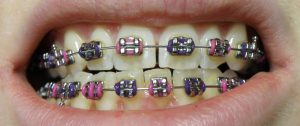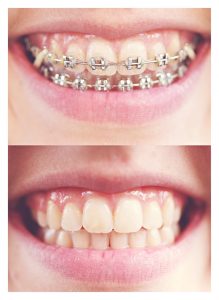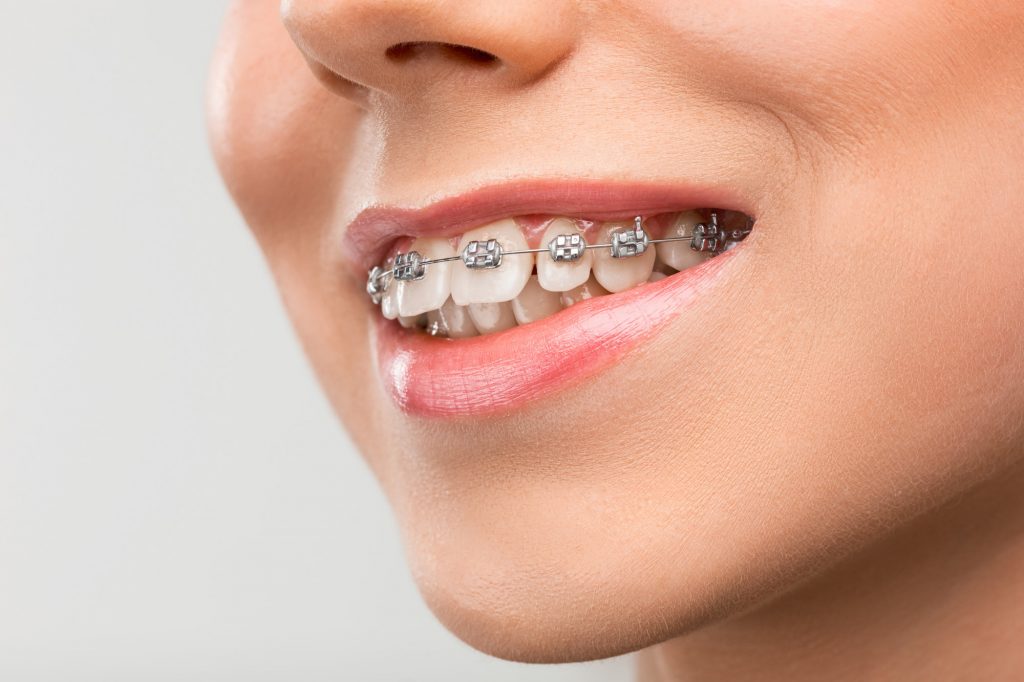Having a beautiful smile is important for a person’s self-esteem, but aligned teeth are also a critical part of oral health. If you suffer from crooked or misaligned teeth there are corrective options available. Dental braces are the most common form of corrective orthodontics used in modern dentistry. There are a few different types of braces to choose from, each of which offers its own unique benefits. (company) is here to tell you everything you need to know about dental braces, the cost of braces, and what to expect from your treatment. This information will help you make an informed decision about installing teeth braces to correct your smile.
What Are Teeth Braces?
Dental braces are an orthodontic treatment device used to correct misaligned and crooked teeth. They are made of metal and wires typically and attached directly to the surface of the teeth. A brace or bracket is affixed to each tooth and wires or bands are then used to help move the teeth into their new positions. Teeth braces are an effective way for people of all ages to correct their teeth alignment. However, it is common for children between the age of 10 and 15 to make use of this corrective procedure.
How Braces Straighten Teeth in Children and Adults
Teeth braces are customized to meet the needs of every patient. A person’s dental braces treatment plan will depend on their age, tooth structure, jaw structure, and their overall cosmetic goals. Dental braces work on children and adults in the same way. The main difference is that with children, their bones are much softer so the treatment tends to be shorter and last longer once complete. For adults, it usually takes longer to correct misalignments, and a retainer must be worn to maintain the results.
Brace brackets are placed on the surface of the teeth and then wires and bands are used to guide the teeth into a new position. Adjustments to the bands or wires will be made every few weeks as the teeth make their journey to their new placement. Now that you understand how braces work, let’s take a closer look at the components used to realign the teeth.
- Dental Braces Bracket – most teeth braces used brackets. They are very small pieces of ceramic or metal that have a square shape. They are affixed to the middle of each tooth and further staggered depending on the individual treatment plan.
- Dental Braces Elastic Ligature – these are the small bands of rubber that circle each bracket. They help keep the archwire in the slot and guide each tooth to its new position. There are many different colors and sizes of elastic ligatures to meet a variety of needs.
- Dental Braces Rubber Band – unlike ligature bands that are attached horizontally, these are bands that are attached vertically. They hold both the upper and lower brackets together to help realign the jaw of the patient. They need to be installed and removed daily by the patient themselves.
- Dental Braces Archwire – this is a metal component fitted through the middle of each bracket. It places constant pressure on each tooth to help move them to a new position.
- Dental Braces Coil- coil springs are placed between brackets if teeth overlap. Not every patient will need coils, only those that need to separate overlapping teeth.
Health Risks of Crooked Teeth
Correcting misaligned and crooked teeth improve the aesthetics of your smile, but also offer other health benefits. Straight teeth are easier to clean, floss, and maintain. Crooked teeth can lead to cavities, reduced ability to chew, gingivitis and periodontal disease, worn down enamel and temporomandibular joint dysfunction among others. Misalignment and crooked teeth can also lead to tooth loss or loose teeth.
Dental Braces and Retainers: Types, Care, What to Expect
Moving forward with orthodontic treatment is a great way to restore oral function and improve the aesthetics of your smile. There are a few different options to choose from when it comes to dental braces. Adults may prefer options that are less visible, while adolescents may prefer those that are more durable. Let’s take a closer look at the four most common types of braces available for orthodontic correction.
Traditional Metal Teeth Braces
Traditional metal braces are the most common and affordable corrective option. They are effective in fixing misaligned teeth, jaw alignment problems, crooked teeth, and crowded teeth. Metal braces allow a dentist to use small adjustments over time to change the position of the teeth or jaw. Though most often used in children and teens, adults who are not concerned with the look of metal brackets may also use this type.
Clear Teeth Braces
Invisible or ceramic braces are a clear option that works in the same way as traditional metal braces. The only difference is that instead of metal brackets, they have brackets that are the same color as the patient’s natural tooth. It makes them less noticeable, and the bands used on the brace are also clear. This type of orthodontic treatment is ideal for older teens and adults.
Headgear & Dental Braces
For more serious cases, dental headgear may be required to correct bit issues. This is an appliance that used a neck strap and is attached to the face paired with dental braces. Usually, it is only needed to correct a crossbite, overjet, open bite, or underbite. Children are the only patients that can make use of headgear for bite correction as their jawbones are still underdeveloped. They also must be used with braces, never on their own.
Lingual Dental Braces
Lingual braces are not as common but they are equally effective. They are a less visible orthodontic treatment that is similar to traditional braces. Instead of the braces being on the front of the teeth, the wires and brackets are in the inside or rear of the teeth. They still use metal or ceramic brackets and metal wires, however, they are less visible since they are installed in the rear of the teeth.
Clear Aligner Teeth Braces
Clear aligner orthodontics is a modern take on the traditional braces. They are clear trays that can be removed but are just as effective as traditional braces. Each aligner tray will need to be worn for 22 hours a day for a period of at least three weeks. Then, a new tray will be issued that has a slightly different shape to keep your teeth in motion. They are a popular option for adults and teens who prefer not to have visible braces.
What To Expect When Being Fitted For Dental Braces
The first step in getting fitted for teeth braces is the consultation. Your orthodontic dentist will survey your oral health and the position of your teeth prior to creating a customized plan for your care. Once your treatment plan is created and you have chosen which type of braces you would like fitted, the dentist will perform a deep cleaning on your teeth. If there are other treatments required such as exactions or fillings, these will be performed prior to your braces fitting.
The first appointment following your deep cleaning will be for x-rays. Molds of your teeth will also be made during your first fitting appointment. Your second appointment will be to bond the brackets to the teeth. In all, this will take about two hours from start to finish. The dentist will completely dry the surface of the teeth and then adhere the brackets to the using a special adhesive. It will be cured and set with a dental light. Once all the brackets are cured, the dentist will thread archwire through each bracket and install the ligatures to hold everything in the proper places.
Every six to eight weeks the patient will need to visit the dentist in person to have the archwires adjusted and the elastics refreshed. This will also allow the dentist to track the progress, perform cleanings, and check for any other complications. From start to finish dental braces treatments can last anywhere from 18 months to three years.
Teeth Braces Removal & Aftercare
Once the treatment has been completed, the dentist will remove the wires and brackets from the teeth. Post removal the enamel will be cleaned and polished to a bright shine. The orthodontist will also issue the patient. A retainer which will need to be worn to help the teeth, maintain their setting.
It is important to follow the directions for food choices that your dentist provides while you wear braces. Sticky or hard food should be avoided as should excessive sugars. It is important to take care of your teeth while you have braces and following their removal. This means close attention to cleaning, flossing, and in-office visits.
Dental Braces Cost
Most people worry about the cost of braces and may avoid the treatment in an effort to save money. It is worth noting that dental insurance covers most dental brace treatments, especially traditional braces. Children’s braces are often covered in full while braces for adults are partially covered. The cost of teeth braces depends on the length of treatment, the needs of the patient, and the type of orthodontics chosen. The consultation fee for most dentists will fall between $250-$300 regardless of patient age or orthodontics type. The average price range for Invisalign or clear aligners is $3500-$8000, metal braces are $2500-$7000, and ceramic braces is $4000-$8000. Retainers are provided as part of the treatment, but replacement retainers will cost about $250 each. Dental insurance usually covers the cost of traditional braces for children and will cover some of the cost of traditional braces for adults. Clear aligners and Invisalign treatments

